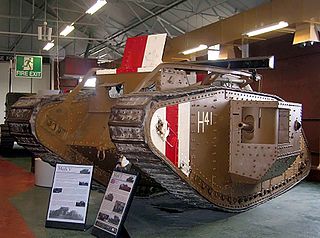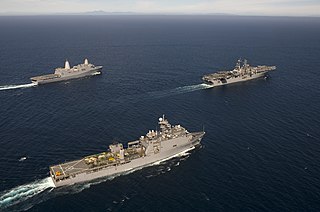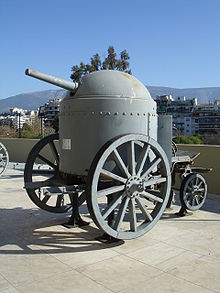
An armoured fighting vehicle or armored fighting vehicle (AFV) is an armed combat vehicle protected by armour, generally combining operational mobility with offensive and defensive capabilities. AFVs can be wheeled or tracked. Examples of AFVs are tanks, armoured cars, assault guns, self-propelled artilleries, infantry fighting vehicles (IFV), and armoured personnel carriers (APC).

A tank destroyer, tank hunter or tank killer is a type of armoured fighting vehicle, predominantly intended for anti-tank duties. They are typically armed with a direct fire artillery gun, also known as a self-propelled anti-tank gun, or missile launcher, also called an anti-tank missile carrier. The vehicles are designed specifically to engage and destroy enemy tanks, often with limited operational capacities.

Self-propelled artillery is artillery equipped with its own propulsion system to move toward its firing position. Within the terminology are the self-propelled gun, self-propelled howitzer, self-propelled mortar, and self-propelled rocket artillery. They are high-mobility vehicles, usually based on continuous tracks carrying either a large field gun, howitzer, mortar, or some form of rocket/missile launcher. They are usually used for long-range indirect bombardment support on the battlefield.

The Phalanx CIWS is an automated gun-based close-in weapon system to defend military watercraft automatically against incoming threats such as aircraft, missiles, and small boats. It was designed and manufactured by the General Dynamics Corporation, Pomona Division, later a part of Raytheon. Consisting of a radar-guided 20 mm (0.8 in) Vulcan cannon mounted on a swiveling base, the Phalanx has been used by the United States Navy and the naval forces of 15 other countries. The U.S. Navy deploys it on every class of surface combat ship, except the Zumwalt-class destroyer and San Antonio-class amphibious transport dock. Other users include the British Royal Navy, the Royal Australian Navy, the Royal New Zealand Navy, the Royal Canadian Navy, and the U.S. Coast Guard.

A warship or combatant ship is a ship that is used for naval warfare. Usually they belong to the navy branch of the armed forces of a nation, though they have also been operated by individuals, cooperatives and corporations. As well as being armed, warships are designed to withstand damage and are typically faster and more maneuverable than merchant ships. Unlike a merchant ship, which carries cargo, a warship typically carries only weapons, ammunition and supplies for its crew.

The FV4007 Centurion was the primary British Army main battle tank of the post-World War II period. Introduced in 1945, it is widely considered to be one of the most successful post-war tank designs, remaining in production into the 1960s, and seeing combat into the 1980s. The chassis was adapted for several other roles, and these variants have remained in service. It was a very popular tank with good armour, mobility, and a powerful main armament.

Operation Herkules was the German code-name given to an abortive plan for the invasion of Malta during the Second World War. Through air and sea landings, the Italians and Germans hoped to eliminate Malta as a British air and naval base and secure an uninterrupted flow of supplies across the Mediterranean Sea to Axis forces in Libya and Egypt.

Landing craft are small and medium seagoing watercraft, such as boats and barges, used to convey a landing force from the sea to the shore during an amphibious assault. The term excludes landing ships, which are larger. Production of landing craft peaked during World War II, with a significant number of different designs produced in large quantities by the United Kingdom and United States.

The Universal Carrier, a development of the earlier Bren Gun Carrier from its light machine gun armament, was one of a family of light armoured tracked vehicles built by Vickers-Armstrongs and other companies.

The Ordnance quick-firing 6-pounder 7 cwt, or just 6-pounder, was a British 57 mm gun, serving during the Second World War as a primary anti-tank gun of both the British and United States Army. It was also used as the main armament for a number of armoured fighting vehicles.
Equipment losses in World War II or Matériel losses in World War II refers to military equipment destroyed during World War II, the deadliest and most costly war in human history.

The Ordnance QF Hotchkiss 6 pounder gun Mk I and Mk II or QF 6 pounder 8 cwt were a family of long-lived light 57 mm naval guns introduced in 1885 to defend against new, small and fast vessels such as torpedo boats and later submarines. Many variants were produced, often under license, which ranged in length from 40 to 58 calibres, with 40 calibre the most common.

An amphibious warfare ship is an amphibious vehicle warship employed to land and support ground forces, such as marines, on enemy territory during an amphibious assault.
HMS Misoa was a Maracaibo-class LST Mk.I tank landing ship of the British Royal Navy during World War II. A converted Lake Maracaibo oil tanker, she took part in the invasions of North Africa, Sicily, and Normandy.
The following index is provided as an overview of and topical guide to Wikipedia's articles on recreational dive sites. The level of coverage may vary:

HMCS Prince Henry was an armed merchant cruiser and a landing ship infantry during World War II for the Royal Canadian Navy. The ship began service as the ocean liner SS Prince Henry for the Canadian National Steamship Company servicing ports along the Canadian British Columbia Coast and cities in the United States Northwest. However, lack of commercial opportunity and the arrival of the Great Depression forced the vessel's owners to send Prince Henry to ply the passenger trade along the North American eastern seaboard. In 1937, the vessel was chartered by Clarke Steamship Company and renamed SS North Star for service in the Caribbean Sea and the Gulf of St. Lawrence. The Clarke Steamship Company purchased the vessel outright in 1938. In 1939, with the outbreak of World War II, North Star was one of the vessels acquired by the Royal Canadian Navy for naval service, which returned the ship to its original name.


























